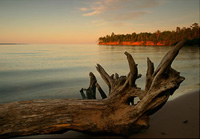Waterway Regulations and The Public Trust Doctrine
Waterway protection
The Public Trust Doctrine applies to all navigable waters, which are defined as any waterway on which it is possible to float a canoe or small watercraft at some time during the year. The Public Trust Doctrine protects the people of Wisconsin’s rights to:
- Transportation and navigation on waterways.
- Protection of water quality and aquatic habitat.
- Recreational activities, including boating, fishing, hunting and swimming in waterways.
- Enjoyment of scenic beauty while on the water.
The state and the DNR protect these rights through permitting requirements for water projects and enforcement actions to stop unauthorized impacts. Also, local zoning ordinances that limit development along navigable waterways help to ensure near-shore development does not result in unintended impacts that interfere with public rights.
History of the Public Trust Doctrine
Since 1787, when the Northwest Ordinance was adopted to govern the Wisconsin Territory, the state's navigable waterways have been considered public and for the use of all citizens. Article IX of the Wisconsin Constitution declares that all navigable waters are "common highways and forever free" and held in trust by the state of Wisconsin. The DNR has been charged with the duty to protect the public trust in our navigable waters.
Wisconsin citizens have also taken action to protect the public interest in navigable waters and have had a significant impact on the Public Trust Doctrine. Watch how their efforts have benefitted all Wisconsinites in this three-part video series Champions of the Public Trust Part 1 and read about their efforts in Champions of the Public Trust.
Riparian Rights and Navigable Waterway Access
Wisconsin law recognizes that an owner of land that borders lakes and rivers, known as a riparian owner - holds rights to use the water next to their property. Riparian rights include the use of the shoreline, reasonable use of the water, and a right to access the water. The Wisconsin State Supreme Court has ruled that when conflicts occur between the rights of riparian owners and public rights, the public's rights are primary and the riparian owner's are secondary.
Wisconsin's stream and lake access laws
Determining Waterway Jurisdiction
Navigability and ordinary high water mark determinations on a waterway decide whether the DNR and local governments have jurisdiction over projects that may impact the waterway, including zoning setbacks, shoreline erosion control, pier placement, dredging and other projects. See Determining Waterway Jurisdiction for more information.
Additional Regulations
See Waterways Permitting Process for an overview of permitting options and process under the DNR Waterways Program.
The U.S. Army Corps of Engineers may require permits for dams, dikes and other structures in federal navigable waters and for the discharge of dredged or fill material into waters and wetlands. The U.S. Coast Guard regulates the construction of bridges and causeways over federal navigable waters.
Local governments (counties, cities, villages, towns) use floodplain and shoreland zoning to control development along lakeshores and streams through permit programs for buildings, land disturbance and other activities in shoreland and floodplain areas.
We are all responsible for water rights protection. You can protect water rights by following proper procedures and obtaining needed permits for activities in public waters. You can also report activities that may be in violation of laws so that damages can be avoided or corrected and voice your opinions to state and local governments.

